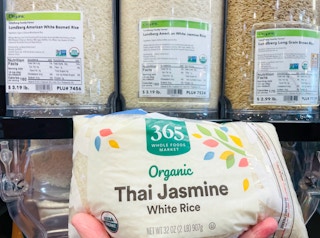Just when you thought the time of food shortages was maybe coming to an end, CNBC is reporting on a looming global rice shortage — the biggest in nearly 20 years.
So what’s happening? The global rice shortage can be attributed to several factors, but climate change is the short summary. Last year China and Pakistan, two major rice producers, experienced severe flooding that damaged their crops. Meanwhile, China also suffered from droughts and heat waves, which further impacted the rice crops. It’s clear that these climate-related events have taken a toll on rice production worldwide.
On top of that, the Russian invasion of Ukraine has contributed to the rice shortage by driving up demand. Ukraine is a significant exporter of wheat globally, and due to the shortage of Ukrainian grain exports, many people have turned to rice as an alternative. This sudden increase in demand has put pressure on rice supplies and contributed to the current shortage.
Rice was already expensive thanks to inflation, and prices will probably keep going up until the rice crop supply can meet the global demand.
Yep, there are some things that are getting cheaper, but rice isn’t one of them. Here’s what you need to know about the rice shortage:
1. Rice prices are up nearly 10% since 2022, and related products are even more expensive.

According to the Consumer Price Index, rice prices have already risen 9.5% since March 2022. Related products like cereals, many of which are made from rice, are up in price 12.5% year over year since March 2022. Long-grain white rice specifically saw an average price increase nationally of 12.7% since last March.
And since we haven’t hit the most dire part of the expected rice shortage, our decade-high rice prices are expected to get worse before they get better.
2. The rice shortage is expected to be short-lived.
Thankfully, experts believe the rice shortage will only last until 2024. A surplus in rice crops is expected as soon as next year, with an expected 10% potential price reduction once supply increases and gets us closer to meeting global demand.
However, much of the potential rice rebound relies on weather conditions in India and China. While the monsoon season in India is forecasted to be a normal one, extreme heat waves and droughts in China may threaten rice crops for upcoming seasons.
3. Shop smart to reduce the financial impact of the rice shortage.

The Krazy Coupon Lady has plenty of tools to help you save money on rice. First, keep tabs on our Minute Rice coupons, where you can find Ibotta rebates and other deals on that brand.
You can also save money on rice by skipping the prepackaged containers and filling your own bags in the WinCo bulk foods section (or if you’re feeling fancier, the Whole Foods bulk foods section).
While we’re probably a long way away from stock-up prices for rice, bookmark that page to have a good idea of what prices to look for.
4. Trying to avoid the rice price hikes? There are lots of rice alternatives.

If you’re looking for rice substitutes amid the shortage, you have a slew of options, many of which are healthier than traditional long-grain white rice. These include:
- Adlai: An heirloom grain popular in the Philippines, adlai is a gluten-free grain grown in Asia. It’s a popular choice for people cutting carbs.
- Barley: Barley has more calcium and fiber than traditional rice.
- Broccoli rice: Get all the benefits of broccoli with the texture of your favorite starch.
- Buckwheat/kasha: High in fiber and protein and lower in calories, buckwheat (or kasha) is more nutritious than traditional rice.
- Bulgur: Bulgur is made from cracked wheat groats and is often used in dishes like tabbouleh.
- Cauliflower rice: Get all the fiber and nutritional benefits of cauliflower, plus the white color of rice.
- Chickpea rice: Fans of hummus will likely enjoy this protein-rich choice.
- Corn grits: Corn grits are a good base for many dishes that need a rice substitute and can accommodate a wide variety of flavor profiles.
- Couscous: Made from crushed durum wheat semolina, couscous has more fiber and nutrients than white rice.
- Farro: Farro is a nutritious, high-fiber, protein-rich whole wheat grain that can be cooked and used similarly to rice.
- Orzo, pastina, and risoni: These petite pastas can all sub in for rice in a pinch.
- Quinoa: Quinoa is higher in protein and fiber than rice and an Earthier flavor but has a texture that can work as a rice substitute.
- Shirataki rice: Also called “miracle rice,” shirataki rice is made from the root of the konjac plant. It’s low in calories and carbs and has a chewier texture than traditional rice. It absorbs most flavors well, making it a good substitute in many dishes without compromising taste.
- Zucchini rice: Low calorie and high in water content, zucchini rice works similarly to zucchini noodles in terms of a veggie substitute for a starch.
Download the KCL app to add and redeem coupons in store




























































































